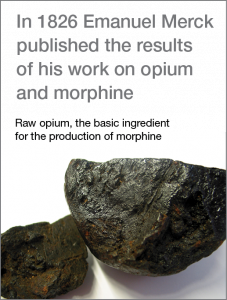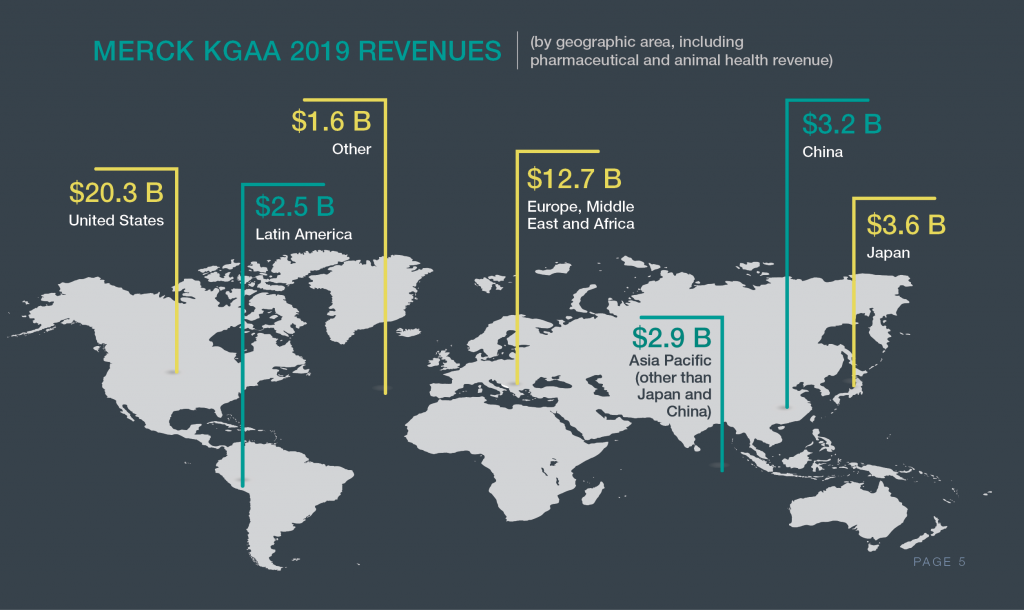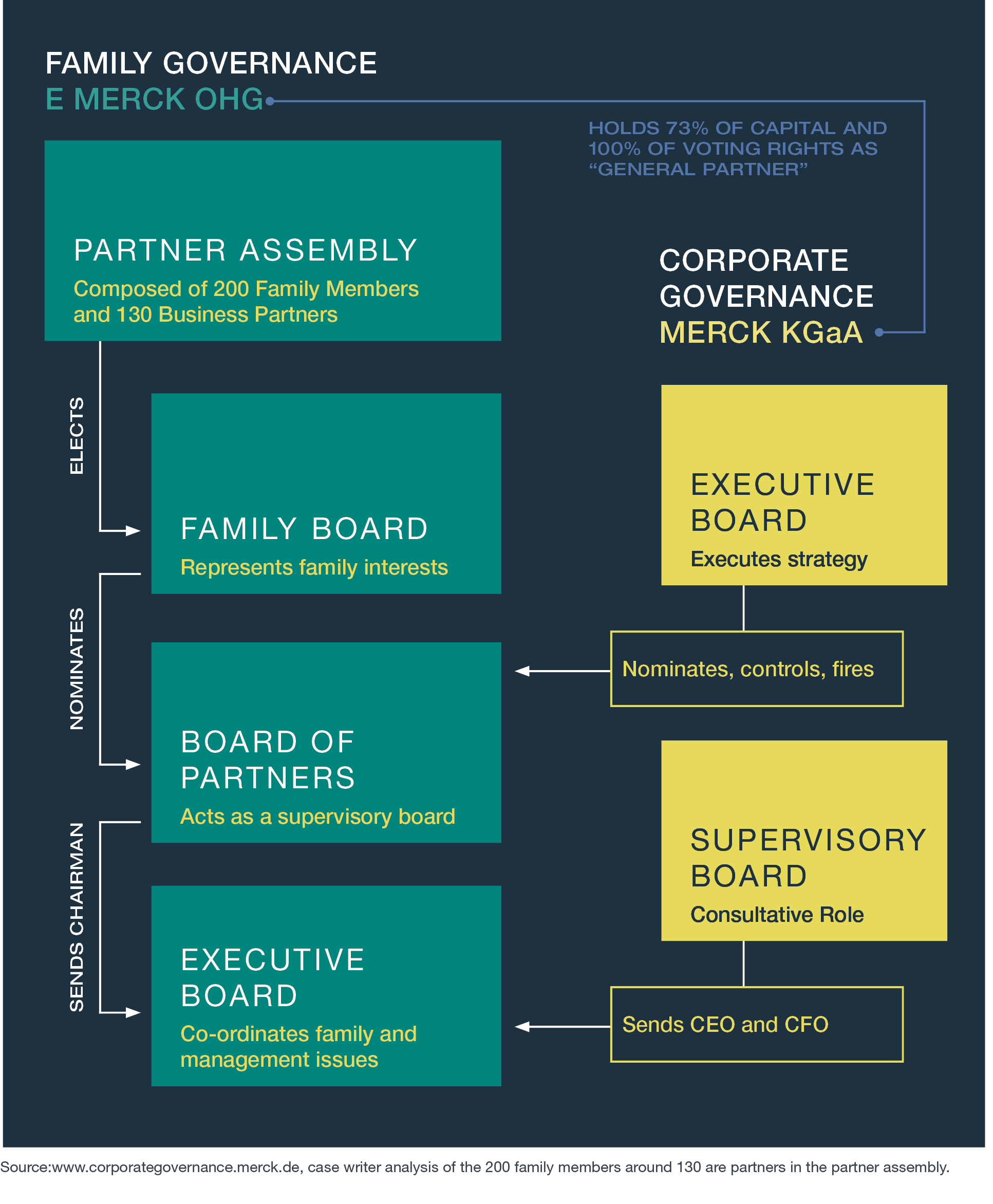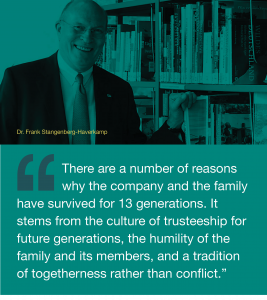Consider this.
You’re born into a centuries-old family enterprise, dating back to 1668. Three and a half centuries.
What began as a single pharmacy in a small German town has grown into a world-leading science and technology company – with cutting edge research and top of the line products and services in healthcare, life sciences, and performance materials.
Today, your family enterprise owns the oldest pharmaceutical and chemical company in the world – operating in 66 countries, employing 56,000 people, earning annual revenues (2019) of more than $19.65 billion USD.
Over 350 years have passed. The pharmaceutical industry has changed immensely, in nearly every way.
And yet the company remains family-owned to this day.
“I always tell the next generation members: you are caretakers, you are trustees and nothing else. More than 50,000 people work for the company every day and their families depend on it. All you have to do is make sure that this heritage is passed on in one piece to the next generation.”
Dr. Frank Stangenberg-Haverkamp
Chairman of the Executive Board & 11th generation Merck family member
Naturally, your family has also grown – the current count sits at 230-odd members. Headquarters are still located in that small town near Frankfurt, but now family members are spread around the world.
And you don’t lack for challenges.
- How do you prevent strife and conflict from forcing your family into the same fate to which so many other family businesses succumb?
- How do you ensure the business also thrives, while preparing it for the future?
- And how do you identify the next generation of leaders – the ones who will maintain your legacy for years to come?
If you’re the Merck family, you leave nothing to chance.
You prioritize planning the future. You invest in it.
In simple terms, the Mercks have built and sustained a 13-generation legacy by taking the “Be Prepared” adage to a whole new level.
Humble Beginnings
In the summer of 1668, a young apothecary named Friedrich Jacob Merck received his operating license to take over the EngelApotheke (Angel Pharmacy) in the small town of Darmstadt, Germany. So began the Merck family story. The pharmacy’s business was steady for decades, and the shop was consistently passed down from generation to generation. Indeed, the original pharmacy is still open for business today, and is operated by one of Friedrich’s descendants.
The death of the pharmacy’s acting manager in 1816 forced a sixth-generation family member, Heinrich Emanuel Merck, to give up his studies in Vienna to take over the business. Emanuel was 22 and a gifted alkaloid chemist. Equipped with his education, Emanuel returned home and began manufacturing alkaloids and other chemicals for the family business. His groundbreaking techniques soon surpassed industry contemporaries, and the company began a transformation from a single family pharmacy to an industry-scale pharmaceuticals and chemicals manufacturer. Amazingly, Emanuel had shifted the industry, and laid the groundwork for the modern pharmaceutical industry we know today.

Emanuel wasn’t just a talented scientist. He was a skilled business leader. In the years that followed the growth into manufacturing, he oversaw the creation of a strong distribution network – as well as expansion to London, New York, and Moscow. All Merck descendants, including Emanuel’s sons, were encouraged to study and train abroad — and to then bring their knowledge and experience back to the family company to facilitate further international expansion.
By 1850, Emanuel saw the need to establish the business as a partnership amongst he and his three sons, who now had an equal share in the gains and losses of both the pharmacy and factory. Growth, expansion and innovation continued, and by the end of the 19th century, Merck was present on every continent in the world.
And it had cemented itself as a family business with ongoing succession.
Two post-war recoveries – and improved governance
Fast forward to the end of World War I. The war had caused extreme upheaval for the business. Raw materials and labour were in short supply, forcing Merck to close multiple foreign subsidiaries. Others were confiscated by foreign governments as a consequence of the war. This included Merck’s largest and most profitable subsidiary in the United States, which was then nationalized and re-established as an independent American company.
Merck’s business soon nosedived, and it lost the foothold Emanuel and his sons had worked so hard, years earlier, to build globally. But the Mercks wouldn’t succumb to defeat. Instead, despite their setbacks, the family revived the business by forging connections with larger competitors in the industry.
After the war, Merck made a crucial strategic decision. In 1920 it put its strained resources towards securing a better governance system, deciding to separate ownership and management. In its first major management restructuring, the Merck family began to appoint non-family members to the management team in an effort to make the company less dependent on the family, to enhance transparency, and to attract top talent. A Board of Directors was established, with the Chair reserved for a Merck family representative.
The infusion of top expertise and external perspectives would prove to be transformative for Merck, particularly following World War II. The boom that took place in Germany following the war, commonly known as Wirtschaftswunder, or “economic miracle,” enabled Merck to establish new international companies, most notably in India and Japan. The expansion was led by Hans Joachim Langmann, a physicist who had married into the Merck family and was serving as CEO. During his 30 years with Merck, Langmann would spearhead growth throughout the globe. Revenue skyrocketed, and the employee count grew to 30,000.
But the international growth was not without consequences. The business lost some of its focus. It became clear that something needed to be done to consolidate the company and sharpen its performance.
The modern day re-structuring
In 1995, Langmann convinced older generation family members to revisit the organization and governance structure for the Merck family enterprise. With seven divisions, multiple subsidiaries, and international operations spread across the world, the structure had become costly, unwieldy, and now heavily criticized.
This spurred another transformation for the family business. Until now, Merck had been a business partnership with an owner community of roughly 100 family members. The decision was made to streamline the organization and governance structure. Merck incorporated itself as a corporation with general partners, with limited shares under specific provisions of German law. It further decided that all members of the Executive Board, as well as all family representatives, would bear personal, unlimited liability. This demonstrated the Merck family’s long-term commitment and personal pledge to the business.
That same year, nearly 30% of the company’s shares were listed on the Frankfurt stock exchange – resulting in the formation of Merck KGAa (Kommanditgesellschaft Auf Aktien, or “limited partnership on shares”). While the goals were to reduce debt and raise capital for acquisitions, the family believed that listing made the family enterprise “better organized, more professional… and helped to maintain transparency.”
The other remaining 70% of the shares remain (to this day) with the holding company, E. Merck KG. These shares are divided into participation certificates, all of which are held individually by the family. The family owners are deliberately not classified as shareholders. Instead, they consider themselves trustees of the company. They receive no salaries, only annual dividends. What the family earns from the business is reinvested in the business.
And that brings us to the Merck of today.

How has the Merck family enterprise endured for so long?
The background of the Merck family history, recounted briefly on the previous pages, indicates that the family are no strangers to overcoming challenges. They’ve endured and rebuilt — not once, but twice — following the destructive consequences of the two World Wars. They’ve continuously adapted to the relentlessly changing, highly competitive field they pioneered. They’ve restructured multiple times to keep operations streamlined and effective.
But what has kept them together throughout it all?
Today, in its 13th generation, there are 258 members of the Merck family. Of those, 157 are equity-holding partners. Can the family enterprise continue to evolve as it faces new, inevitable and unpredictable challenges alongside its own family expansion? How will Merck ensure its long-term sustainability and family unity?
 Below, we identify a number of key elements that have contributed to Merck’s longevity as one of the world’s most iconic business families.
Below, we identify a number of key elements that have contributed to Merck’s longevity as one of the world’s most iconic business families.
1. A focus on growth
The Merck family has identified growth of the business as a key to maintaining sustainability and family unity. As the family grows over the course of generations, each individual’s ownership percentage decreases. Today, 157 family members share 70.3% of Merck. The wealth must increase at a rate that’s satisfying for all family partners, so the business needs to be a rewarding investment for all. This focuses Merck on the need for consistent growth. In recent years, Merck has completed USD $47 billion in acquisitions, while simultaneously unloading products and services that aren’t in line with their plans for the future. Sales have jumped to USD $17.6 billion, and profits have increased to nearly USD $3 billion.
2. A unique dual board system
Merck’s changes to its management structure in 1920 – bringing on non-family members for the first time – eventually laid the groundwork for a unique dual-board system that’s in place today. Management is controlled by the Executive Board, comprised of predominantly non-family members, while a separate Family Board functions as supervision of the overall management. This strict separation of operational management of the business from the family owners allows for efficient communication and fast decision making across the dual boards. It also maintains an effective divide that ensures the family is “relatively removed” from the daily operations of the company.

3. Strong family governance
Merck’s first family constitution was written in 1888, and it continues to evolve over time. It’s currently 150 pages, and its contents are regarded as law by the family – in essence, a contract. Principles covered include transparency, legal rights, and the strict separation of operational management and ownership. The contract operates in a rollover fashion, renewed every 10 years. Family members can only exit when the contract is renewed. No family members opted to exit at the last renewal, reaffirming the commitment and unity that extends throughout the Merck family.
A Partner Assembly – all 157 equity-holding family members – elects the Family Board. Its key accountabilities are to deal with all family matters, to be the chief interface between the family and the business, and to represent the family interests in determining the strategic direction of the business. It meets between six and 10 times a year. Up to 13 members can be elected to the Board, and elections occur every five years. Any interested family member must go through an evaluation process, meet a set of strict selection criteria, and complete a special training program.
Two other family governance structures exist below the Family Board: (1) the Board of Partners (2) the Family Executive Board. Both have specific, well-defined roles within the family governance system. By setting these structures in place in advance, the Merck family has been able to focus on the business, not on issues amongst themselves.
4. Mandated family face time
A key element of Merck’s longevity as a business family has been its commitment to nurture family bonds by spending social time together. The family considers these important investments of time in the bonds that promote family unity, while also facilitating connections amongst all generations to ensure family continuity. Multiple family meetings are held each year, in addition to the annual general meeting. They are followed by social events, typically held at a family member’s home. Separate from company events, there are also organized private family events, such as ski weekends in Switzerland. Family members fund these trips independently, and they are well attended. They are a testament to the desire among the Merck family to maintain a sense of togetherness.
5. A commitment to living family values
Merck family members speak openly about their focus on practicing values in both their business and personal lives. For example, the family is opposed to displays of material wealth. All family members have regular jobs, and don’t live any sort of extravagant lifestyle. There are no private jets in the Merck family. “If you travel in a private jet, you lose contact with the real world,” says Johannes Baillou, current Chair of the Board of Partners for the Merck holding company, and 12th-generation family member. Family members believe they should demonstrate their success by their merit, not their wealth.

6. Discipline in preparing the next generation of trustees
Changeover from one generation to the next typically presents challenges for many business families. Merck has implemented several strategies to facilitate the process and enhance the likelihood of success. As soon as young family members turn 15, they begin to attend special family mentorship meetings each year. One is held for ages 15 through 21, and another for ages 22 through 30. These gatherings introduce future leaders to Merck’s research laboratories and factory operations, while also exposing them to the structure of the business, family values, family contracts, and more.
Joining the family business in a formal role is an accomplishment that must be earned by any next generation family member. They must first complete a university degree or apprenticeship, and then establish a professional career outside of Merck. Only then can younger family members apply for an assessment. If they meet the criteria, it’s off to Merck Family University – a program that collaborates with other institutions like the Frankfurt School of Economics and the Witten Institute for Family Business.
To re-emphasize, business leadership in the Merck family is viewed as a trustee position. As a result, there haven’t been any major issues in leadership transition. Members enter the Family Board in their early 30s, and the older generation is prepared to move on. Older members leave the company entirely at age 75 – no office, no involvement. It’s in the family constitution. They are trustees, and they know the family legacy is being passed into capable hands that have been trained to share, respect, and embody the values that have built Merck over the centuries.
7. Celebrating the family’s Identity and history
The Merck enterprise takes great pride and responsibility in its identity – as a family and as a business. In the 350 years since Friedrich Merck first opened the doors of the EngelApothecary, each of the 13 generations of his descendants have contributed to the history and the ideals of the company. Merck has a separate department specifically dedicated to researching the company’s history. Nurturing this meaningful identity as an enterprise maintains the group’s unity and purpose. Having well defined family and corporate governance mechanisms and structures keeps the focus on meeting the industry together as a united front, free from the distractions of internal strife and complications.
Here in late 2020, Merck considers itself a continuous work in progress.
The family believes in a long-term vision. It has worked hard to maintain family harmony. Its members are committed to growth and evolution, with an unwavering willingness to adapt. They honour their family identity.
Merck recently celebrated its 350th anniversary, and even gave it a theme: Always curious: imagine the next 350 years. And it appears they’re right on track to get started. Tomorrow’s family leaders are “being prepared” as you read this, hard at work at Merck Family University.
Questions to consider for your business:
- What governance protocols do you have in place – for your family and your business?
- How do you celebrate your family’s identity and history?
- What is your level of readiness and preparation for engaging the next generation?
Download and view as a PDF here.
Jessika McQueen is a freelance writer.
